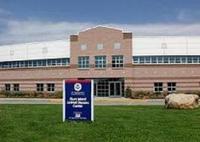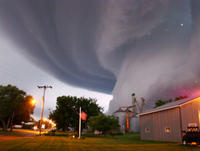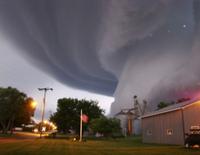-
New U.S. biodedfense R&D network launched
On Monday, Texas A&M System dedicated a new research center which is part of a national network of centers aiming to develop strategies and products to counter bioterrorism, chemical and radiological attacks on the United States, and better strategies to deal with pandemics; the network will have facilities in Texas, Maryland, and North Carolina; the Texas dedication is the culmination of a Manhattan Project-like program for biological countermeasures, launched in 2004 by the Department of Health and Human Services; the research network aims to develop “rapid, nimble and flexible approaches” to vaccine and therapy development, and train the next generation of professionals to sustain U.S. capabilities in these areas
-
-
Scaled-back Kansas biolab would meet U.S. needs

A report by the National Research Council says that it is “imperative” that the United States build a large-animal biocontainment laboratory to protect animal and public health; two options are acceptable: a $1.4 billion Biosafety Level 4 laboratory in Manhattan, Kansas, or a scaled-back Kansas lab tied to a distributed laboratory network in other facilities; a third option will not meet U.S. needs: maintaining current capabilities at Plum Island Animal Disease Center, because the Plum Island facilities do not meet current standards for high biocontainment
-
-
Report: Updated DHS risk assessment of Kansas lab still “technically inadequate”
Congress was unsatisfied with a 2010 DHS risk-assessment study of the proposed National Bio- and Agro-Defense Facility (NBAF) in Manhattan, Kansas, and asked for a new study of the risks, and an evaluation of the new study by the National Research Council; the evaluation says that some of the risk reduction noted in the new DHS risk assessment may be explained by improvements to the latest design plans for the facility, but that despite these improvements, the updated DHS assessment underestimates the risk of an accidental pathogen release and inadequately characterizes the uncertainties in those risks
-
-
Veterinary profession trends short-change biosecurity, food security, public health
More than half of veterinary students in the United States seek training in companion animal or pet medicine – with fewer and fewer graduate veterinary students pursuing Ph.D. training which would prepare them for academic careers, key jobs in the public sector, and some positions in industry; the result is a dwindling supply of veterinarians to fill jobs overseeing and enforcing food safety and animal health standards, conduct research in human drug development and advances in pet health, and participate in wildlife and ecosystem management, infectious disease control, biosecurity, and agro-terrorism prevention
-
-
Kansas biolab project on life support

In 2008, DHS chose Manhattan, Kansas, as the location for a new, $650 million BioLab Level 4; the new lab was planned as a replacement for the aging Plum Island facility; critics argued that the lab’s location — in the middle of Tornado Alley and at the center a region which is home to a large portion of the U.S. beef industry – was not ideal for a facility doing research on deadly animal and human pathogens; it now appears that budgetary considerations have doomed to project
-
-
Kansas State takes over pathogen research from Plum Island
As New York’s Plum Island Animal Disease Center begins to shut down, much of its pathogen work will be transferred to Kansas State University’s Biosecurity Research Institute in preparation for the opening of DHS’ new National Bio and Agro-Defense Facility (NBAF) in nearby Manhattan, Kansas
-
-
How safe is Kansas bio lab from twisters?

DHS officials say they are confident that the proposed bio-defense lab in Manhattan, Kansas, located in the heart of tornado alley, is capable of withstanding a direct hit from a powerful twister; engineers have hardened the $650 million National Bio and Agro-Defense Facility (NBAF) to withstand wind speeds of up to 230 miles per hour; but critics of the planned facility argue that the new standards are inadequate and that the facility must be further reinforced to ensure that in the event of a natural disaster the deadly pathogens and viruses stored there are not spread
-
-
Kansas House cuts troubled agency's role in funding of bio lab
DHS has chosen Kansas State University (KSU) in Manhattan, Kansas, as the location for the new, $650 million Level 4 BioLab, which will replace the aging lab on Plum Island, New York; the federal laboratory will be the U.S. premier facility for research into countering possible bioterrorism attacks and threats to the nation’s food supply; the Kansas Bioscience Authority (KBA) was supposed to handle the issuing of $105 million in bonds to develop the lab, but the KBA’s chief executive has recently resigned under a cloud, and the agency’s business practices are now being investigated the Johnson County District Attorney; the Kansas House voted to cut the KBA out of handling the bond issue; “We didn’t want any kind of hint of a problem,” said one House member
-
-
Risk of agroterrorism growing
The United States imports so much of its food and food ingredients from other countries, that terrorists have many more opportunities to harm Americans and damage the U.S. economy; a high FDA official said that increased U.S. attention to the issue and questions over whether hostile actors have the technical capacity to mount such an attack notwithstanding, the likelihood of being poisoned by intentionally contaminated food is growing
-
-
Mystery of 200 dead Wisconsin cows solved
Researchers find the cause of the mysterious deaths of 200 cows in Wisconsin: the sweet potato; the animals were killed by a poison found in spoiled sweet potatoes that were part of the cattle’s feed
-
-
New U.S. food safety law goes into effect
On 15 December the U.S. Centers for Disease Control and Prevention (CDC) issued its first estimate since 1999 of the toll of food-borne diseases in the United States: 48 million people sick each year, 128,000 hospitalized, and 3000 deaths; in the biggest overhaul of food safety in the United States since the 1930s, President Barack Obama yesterday signed a law giving the Food and Drug Administration (FDA) more power to inspect and shut down food producers yesterday, President Obama; critics say the law does not go far enough
-
-
Fourth International Symposium on Agroterrorism announced
The fourth International Symposium on Agroterrorism is scheduled for 26-28 April 2011, at the Hyatt Regency and Westin Crown Center Hotels in Kansas City, Missouri; it will focus on the need closely to communicate and coordinate among private industry, law enforcement, government agencies, science, academia, and the health and medical professions in order to protect the global food supply
-
-
Hope for Plum Island in unease about Kansas biolab?
Last month the National Research Council issued a safety report which concluded that there is a 70 percent chance of pathogen release from the proposed Manhattan, Kansas BioLab-4 over a 50-year period; The New York congressional delegation points out that upgrading safety at Plum island will cost far less than the $400 million price tag for the Kansas lab
-
-
Hutchinson: Canada's food system at risk from terrorism
Fomer DHS undersecretary Asa Hutchinson says the Canadian food industry is not sufficiently protected from tampering and potential terrorism; the Canadian food industry points out that Canada’s food safety system is tied for fourth place with the United States, behind Denmark, Australia, and the United Kingdom
-
-
Veterinary students train to help in agro-terrorism situations
Because of the number of feedlots in Kansas, the state could be a prime target for agro-terrorism; Kansas State University veterinary medicine students take part in two different U.S. Department of Agriculture preparedness programs: the foreign animal disease practitioner’s training course and agriculture emergency response training; the programs train veterinarians to aid in relief efforts and protect the public in hazardous situations
-
- All
- Regional
- Water
- Biometrics
- Borders/Immig
- Business
- Cybersecurity
- Detection
- Disasters
- Government
- Infrastructure
- International
- Public health
- Public Safety
- Communication interoperabillity
- Emergency services
- Emergency medical services
- Fire
- First response
- IEDs
- Law Enforcement
- Law Enforcement Technology
- Military technology
- Nonlethal weapons
- Nuclear weapons
- Personal protection equipment
- Police
- Notification /alert systems
- Situational awareness
- Weapons systems
- Sci-Tech
- Sector Reports
- Surveillance
- Transportation
Advertising & Marketing: advertise@newswirepubs.com
Editorial: editor@newswirepubs.com
General: info@newswirepubs.com
2010-2011 © News Wire Publications, LLC News Wire Publications, LLC
220 Old Country Road | Suite 200 | Mineola | New York | 11501
Permissions and Policies
Editorial: editor@newswirepubs.com
General: info@newswirepubs.com
2010-2011 © News Wire Publications, LLC News Wire Publications, LLC
220 Old Country Road | Suite 200 | Mineola | New York | 11501
Permissions and Policies
